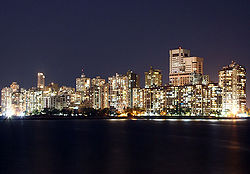Cuffe Parade | |
|---|---|
Neighbourhood | |
 A view towards the World Trade Center | |
| Coordinates: 18°55′N72°49′E / 18.91°N 72.81°E | |
| Country | India |
| State | Maharashtra |
| District | Mumbai City |
| Metro | Mumbai |
| Government | |
| • Type | Municipal Corporation |
| • Body | Brihanmumbai Municipal Corporation (MCGM) |
| Elevation | 4 m (13 ft) |
| Languages | |
| • Official | Marathi |
| Time zone | UTC+5:30 (IST) |
| PIN | 400005 [1] |
| Area code | 022 |
| Vehicle registration | MH 01 |
| Civic agency | BMC |

Cuffe Parade is a historic and significant business district of the city of Mumbai, India. It is home to a collection of commercial and office high-rises. It is bordered to the north by Nariman Point which, along with Cuffe Parade, forms the greater CBD region of the city.


